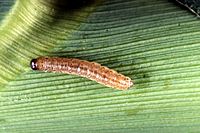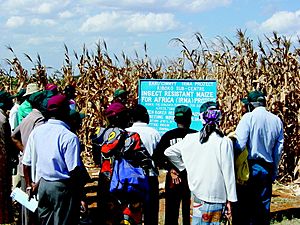Genetically modified maize facts for kids
Genetically modified maize (also known as GM corn) is a type of corn that has been changed using genetic engineering. This means scientists have added specific genes to the corn to give it new, helpful features. For example, some GM corn can fight off pests or survive when certain herbicides (weed killers) are used.
Farmers in many countries now grow GM corn that has both these traits. However, some people are concerned about GM corn. They wonder if it could affect human health, other insects, or even other plants if its genes spread. One type of GM corn, called Starlink, was only approved for animal food in the US. But it accidentally ended up in human food, which led to many food recalls in 2000.
What is GM Corn Used For?
Corn That Resists Weeds
Some types of GM corn are made to be resistant to certain weed killers. This means farmers can spray their fields to kill weeds, and the corn plants will not be harmed.
- In 1996, a company called Monsanto first sold "Roundup Ready Corn." This corn can handle the weed killer called glyphosate.
- Another company, Bayer CropScience, created "Liberty Link Corn," which resists a different weed killer called glufosinate.
By 2011, farmers in 14 countries were growing GM corn that resists weed killers. Even though it's still debated, importing these types of corn into the European Union is allowed. Growing them can help farmers a lot.
Corn That Resists Insects

Some GM corn is designed to protect itself from harmful insects.
Bt Corn
Bt corn is a special kind of GM corn. It has genes from a bacteria called Bacillus thuringiensis (that's where "Bt" comes from!). These genes make the corn plant produce proteins that are poisonous to certain insect pests.
- The European corn borer is an insect that causes about a billion dollars in damage to corn crops each year.
- Other insects like corn earworms and rootworms also cause a lot of damage.
When a harmful insect eats Bt corn, the special protein in the plant becomes active in the insect's stomach. This protein then paralyzes the insect's digestive system. The insect stops eating within a few hours and eventually dies.
The first Bt corn was approved in 1996. It helped control the European corn borer. Later, new Bt genes were added to fight corn rootworm larvae.
A study in 2018 showed that Bt corn not only protected itself but also helped nearby fields of regular corn and vegetables. This meant farmers used fewer pesticides on those other crops. For example, between 1992 and 2016, the amount of insecticide used on pepper fields in New Jersey dropped by 85 percent!
Sweet Corn Varieties
Some sweet corn varieties are also genetically modified to resist insects.
- "Attribute" is a brand of insect-resistant sweet corn made by Syngenta.
- "Performance Series" is another insect-resistant sweet corn from Monsanto.
Cuba's GM Corn
Even though Cuba focuses a lot on organic farming, by 2010, they had developed their own type of GM corn. This corn is resistant to the palomilla moth, a pest that harms corn.
Corn That Resists Drought
In 2013, Monsanto introduced the first GM corn designed to handle dry conditions. This corn, called DroughtGard, has a gene from a soil microbe called Bacillus subtilis. This gene helps the corn plant survive better when there isn't enough water.
New Types of Corn Being Developed
Scientists are always working on new kinds of GM corn.
- In South Africa, researchers have created GM corn that resists the maize streak virus (MSV). This virus can harm corn plants.
- Other research is looking into adding a gene from E. coli bacteria to corn. This would allow the corn to produce an important nutrient called methionine.
Why Farmers Plant "Refuges"
To help slow down insects from becoming resistant to Bt corn, farmers who plant Bt corn often have to plant some non-GM corn nearby. This area of regular corn is called a "refuge."
- The United States Environmental Protection Agency (EPA) requires these refuges.
- Refuges give pests a place to live and reproduce without being exposed to the Bt protein. This helps keep the insect population from developing resistance to the Bt corn too quickly.
- Usually, about 20% of a farmer's corn fields must be a refuge.
In the past, some farmers didn't follow these rules, which raised concerns that insects might become resistant faster. To make it easier for farmers, seed companies now sell bags that contain both Bt corn seeds and refuge seeds mixed together. This is called "Refuge in a Bag" (RIB).
When Pests Become Resistant
Sometimes, insects can develop resistance to the Bt protein over time, especially if refuges are not managed correctly.
- In 2009, scientists found that the pink bollworm had become resistant to an early type of Bt cotton in India. This was the first time Monsanto confirmed Bt resistance anywhere in the world.
- In 2012, a field test in Florida showed that armyworms were resistant to GM corn made by Dupont-Dow. This problem was first seen in Puerto Rico in 2006.
How GM Corn is Regulated
The rules for GM crops are different in various countries. For example, the rules in the US are very different from those in Europe. Also, within one country, the rules can change depending on how the GM crop will be used.
Images for kids
See also
 In Spanish: Maíz transgénico para niños
In Spanish: Maíz transgénico para niños




